Dogs play rough, and things can escalate into a fight quickly. These two are having a good time, but the owners should be aware of signs that indicate a brewing fight and end the interaction immediately.
At a quick glance, dog play and dog fights appear similar. However, there are telltale signs and changes in body language that dog owners need to understand to distinguish between intense, but fun, play and actual aggression and fear-based reactions.
Dogs that are playing often exhibit loose, bouncy movements and relaxed facial expressions. Their ears might be perked up or floppy. Playing dogs may be vocal, but those vocalizations typically include excited barks, yips, or even playful growls. These sounds are often exaggerated and accompanied by other playful behaviors. Dog play is important for training and development. However, things can turn aggressive quickly, which is why dog owners need to remain vigilant.
Whole Dog Journal is reader-supported. If you purchase through links on our site we may earn a commission. Whole Dog Journal does not accept money for its food and product reviews.
Are Dogs Playing or Fighting?
It’s important to note that even playful interactions can sometimes escalate into fights, especially if one or both dogs are feeling stressed, overexcited, or threatened. “While excited barking and other vocalizations are signs of play, if they are sustained, not welcomed too intense, they can also cause things to escalate, says Allie Bender, a dog behavior consultant and the co-author of “Canine Enrichment for the Real World.”
Sometimes other environmental triggers cause escalation (e.g., a person walking by, a car passing). “Another dog entering the environment can absolutely change the dynamics. Really any environmental change can cause changes in behavior. And then there are kiddos who don’t yet have self-regulation skills and escalate because they can’t calm themselves back down from playing well,” Bender says.
Signs of dogs at play
Things to watch for that signal healthy play, according to Shelter Playgroup Alliance protocol and Bender, include:
Wagging tails, especially when accompanied by other playful behaviors.
Playful growls or barks that often accompanied by a happy expression on the dog’s face.
Playful nipping is a common form of play, but it should be gentle.
Play bows, where they lower their front end while keeping their rear end raised. This is a clear signal of playful intent.
Taking turns being dominant or submissive. They may chase each other, wrestle, or engage in mock biting.
No sustained aggression or intent to harm. Playful interactions generally involve brief periods of aggression followed by playful behaviors and rest.
Signs Your Dog Is Aggressive (Or About To Be)
To get ahead of a fight, watch for signals that things are getting serious:
Tense muscles, raised hackles, and a stiff tail are often signs of aggression or fear.
Intense sustained growls or snarls and pinned ears are often a sign of aggression or submission.
Aggressive behavior during otherwise playful biting or nipping, especially if excessive or accompanied by other aggressive behaviors.
Growling or snarling is a common sign of aggression, especially when accompanied by other aggressive behaviors.
Baring teeth is another sign of aggression, and it is often accompanied by growling or snarling.
Lunging or biting is the most obvious sign of aggression, and it should always be taken seriously.
Stiff rigid bodies. Aggressive dogs often have a stiff or rigid body, and they may also have their ears pinned back or their tail tucked under their body.
If things do escalate, it’s important to quickly and safely break up the dog fight. How quickly depends on where the interactions are taking place and who’s involved.
“For me, what point to step in depends on the situation. For example, if two dogs who have lived together for years are playing and I know they have a history of appropriate communication and healthy play skills I may wait longer to step in if I see yellow flags,” Bender says.
How to Tell If Puppies Are Playing or Fighting
Puppies introduce a different dynamic. If you are dealing with young dogs who don’t have a relationship and are playing at a dog park, daycare, or a new play date, you may want act sooner. “In those situations, I may interrupt more frequently than is necessary, even before there are yellow flags. That way I’m encouraging them to take breaks and giving everyone a moment to regroup before choosing to engage in play again,” Benders says.
Remember, if you’re concerned about your dog’s behavior or interactions with other dogs, it’s always a good idea to consult with a veterinarian or animal behaviorist. They can provide personalized advice and help you address any issues you may be facing.
